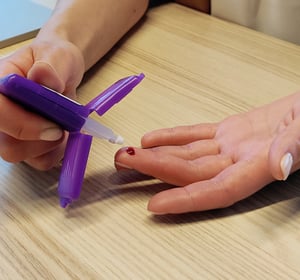Share this
what is microsampling? applications in translational research
by Neoteryx Microsampling on Mar 15, 2019 3:25:00 AM
 Over the past few years, the field of medicine has benefitted from advancements in biotechnology and research that have brought changes to medical treatments. Once such advancement has provided new convenience, comfort, and efficiency in the area of specimen collection. The advancement is called microsampling.
Over the past few years, the field of medicine has benefitted from advancements in biotechnology and research that have brought changes to medical treatments. Once such advancement has provided new convenience, comfort, and efficiency in the area of specimen collection. The advancement is called microsampling.
Microsampling is a process that allows for the collection of much smaller samples of a biological specimen (urine, sweat, tears, blood) or bio-fluid for laboratory testing. The sample collected using the microsampling process could be as small as 10 to 20 μL, which is why it is referred to as a "microsample."
How can a microsample of a bio-fluid provide enough information to help a researcher investigate and understand the underlying mechanisms of a medical condition? And, how can the related data be translated to the clinical side to drive improvements in medical care?
Here Are a Few Ways Microsampling is Useful:
- Some medical conditions require long term medication. Physicians may want to monitor a person's responsiveness to long term medications over time. One of the ways this is done is through scheduled blood draws. Going to a clinic for a blood draw could be risky for some patients, but with remote specimen collection and microsampling, it is possible to monitor a person's progress on their medication without requiring them to leave home.
- Quite a number of medical conditions are hereditary, which can be identified or predicted through genetic testing. Only a small amount of sample is required for genetic testing and genomic sequencing. Microsampling can help researchers and medical practitioners acquire a large database of information, which could be used to identify disorders. Once researchers have this data, they can then explore new treatments.
- Microsampling can help decrease costs and increase convenience by enabling remote specimen collection to be performed by study participants or patients themselves, which can help in terms of decentralization. With microsampling, you do not have to travel to the hospital or lab. Instead, you can collect a specimen sample in the comfort of your home and then send it to the clinic or lab for analysis. This way, you also save on the cost of travel without having to compromise your health. The research or medical staff save on cost as well, since self-collection at home doesn't require the assistance of a healthcare professional.
Microsampling plays an important role in delivering on the promise of translational research that drives improvements in personalized medicine. With microsampling, the future looks brighter for patients, medical practitioners, and the scientists who are constantly looking for ways to improve the field of medicine.

Share this
- Microsampling (206)
- Research, Remote Research (119)
- Venipuncture Alternative (105)
- Clinical Trials, Clinical Research (83)
- Mitra® Device (73)
- Therapeutic Drug Monitoring, TDM (51)
- Dried Blood Spot, DBS (39)
- Biomonitoring, Health, Wellness (30)
- Infectious Disease, Vaccines, COVID-19 (24)
- Blood Microsampling, Serology (23)
- Omics, Multi-Omics (21)
- Decentralized Clinical Trial (DCT) (20)
- Specimen Collection (18)
- Toxicology, Doping, Drug/Alcohol Monitoring, PEth (17)
- Skin Microsampling, Microbiopsy (14)
- hemaPEN® Device (13)
- Preclinical Research, Animal Studies (12)
- Pharmaceuticals, Drug Development (9)
- Harpera Device (7)
- Industry News, Microsampling News (5)
- Antibodies, MAbs (3)
- Company Press Release, Product Press Release (3)
- Environmental Toxins, Exposures (1)
- July 2025 (1)
- May 2025 (1)
- April 2025 (2)
- December 2024 (2)
- November 2024 (1)
- October 2024 (3)
- September 2024 (1)
- June 2024 (1)
- May 2024 (1)
- April 2024 (4)
- March 2024 (1)
- February 2024 (2)
- January 2024 (4)
- December 2023 (3)
- November 2023 (3)
- October 2023 (3)
- September 2023 (3)
- July 2023 (3)
- June 2023 (2)
- April 2023 (2)
- March 2023 (2)
- February 2023 (2)
- January 2023 (3)
- December 2022 (2)
- November 2022 (3)
- October 2022 (4)
- September 2022 (3)
- August 2022 (5)
- July 2022 (2)
- June 2022 (2)
- May 2022 (4)
- April 2022 (3)
- March 2022 (3)
- February 2022 (4)
- January 2022 (5)
- December 2021 (3)
- November 2021 (5)
- October 2021 (3)
- September 2021 (3)
- August 2021 (4)
- July 2021 (4)
- June 2021 (4)
- May 2021 (4)
- April 2021 (3)
- March 2021 (5)
- February 2021 (4)
- January 2021 (4)
- December 2020 (3)
- November 2020 (5)
- October 2020 (4)
- September 2020 (3)
- August 2020 (3)
- July 2020 (6)
- June 2020 (4)
- May 2020 (4)
- April 2020 (3)
- March 2020 (6)
- February 2020 (3)
- January 2020 (4)
- December 2019 (5)
- November 2019 (4)
- October 2019 (2)
- September 2019 (4)
- August 2019 (4)
- July 2019 (3)
- June 2019 (7)
- May 2019 (6)
- April 2019 (5)
- March 2019 (6)
- February 2019 (5)
- January 2019 (8)
- December 2018 (3)
- November 2018 (4)
- October 2018 (7)
- September 2018 (6)
- August 2018 (5)
- July 2018 (8)
- June 2018 (6)
- May 2018 (5)
- April 2018 (6)
- March 2018 (4)
- February 2018 (6)
- January 2018 (4)
- December 2017 (2)
- November 2017 (3)
- October 2017 (2)
- September 2017 (4)
- August 2017 (2)
- July 2017 (4)
- June 2017 (5)
- May 2017 (6)
- April 2017 (6)
- March 2017 (5)
- February 2017 (4)
- January 2017 (1)
- July 2016 (3)
- May 2016 (1)
- April 2016 (2)


No Comments Yet
Let us know what you think